The Pathogenesis of Dementia
VerifiedAdded on 2022/09/15
|12
|3136
|17
AI Summary
Contribute Materials
Your contribution can guide someone’s learning journey. Share your
documents today.

Running Head: DEMENTIA
DEMENTIA
Name
Professor
Institution
Course
Date
Abstract
DEMENTIA
Name
Professor
Institution
Course
Date
Abstract
Secure Best Marks with AI Grader
Need help grading? Try our AI Grader for instant feedback on your assignments.
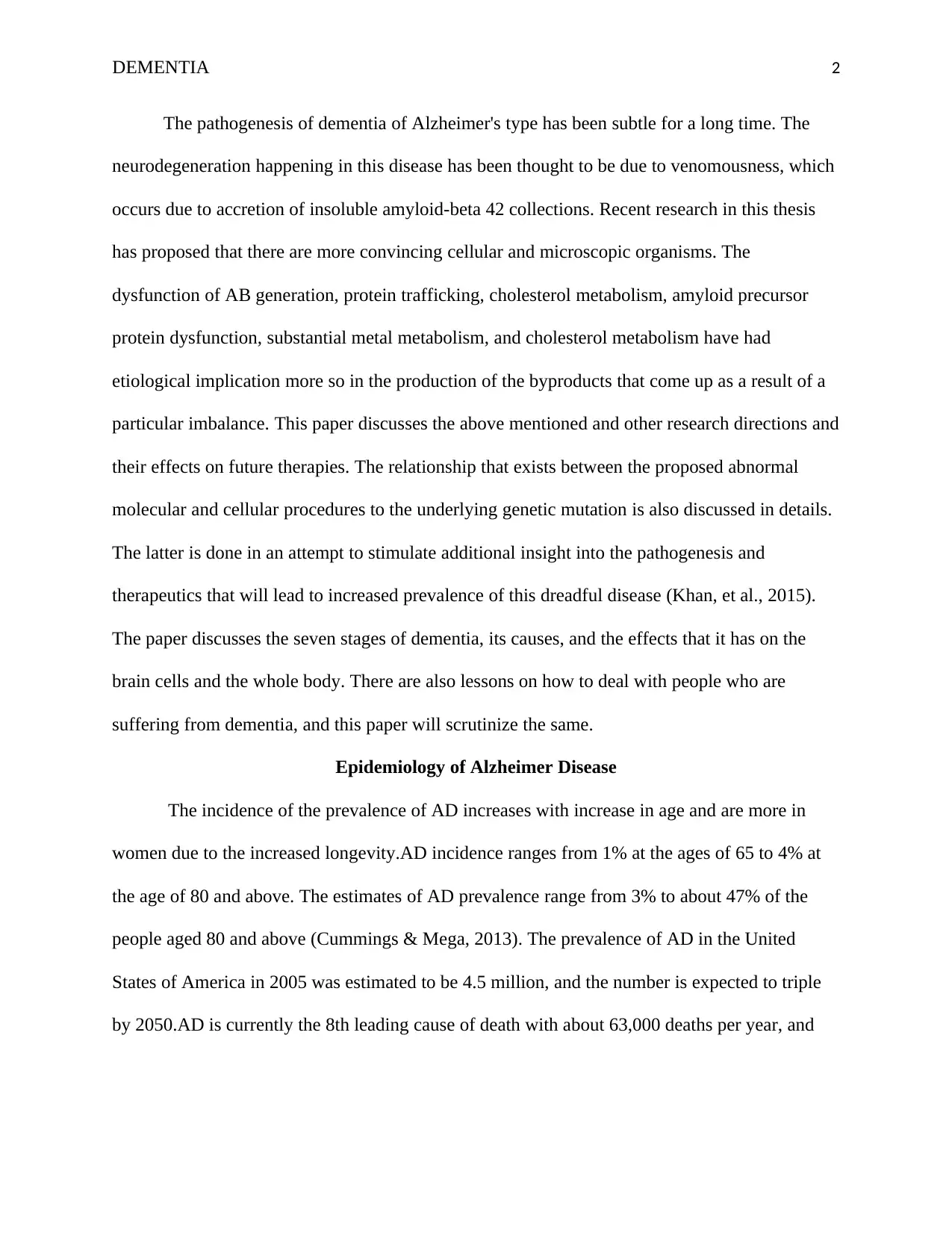
DEMENTIA 2
The pathogenesis of dementia of Alzheimer's type has been subtle for a long time. The
neurodegeneration happening in this disease has been thought to be due to venomousness, which
occurs due to accretion of insoluble amyloid-beta 42 collections. Recent research in this thesis
has proposed that there are more convincing cellular and microscopic organisms. The
dysfunction of AB generation, protein trafficking, cholesterol metabolism, amyloid precursor
protein dysfunction, substantial metal metabolism, and cholesterol metabolism have had
etiological implication more so in the production of the byproducts that come up as a result of a
particular imbalance. This paper discusses the above mentioned and other research directions and
their effects on future therapies. The relationship that exists between the proposed abnormal
molecular and cellular procedures to the underlying genetic mutation is also discussed in details.
The latter is done in an attempt to stimulate additional insight into the pathogenesis and
therapeutics that will lead to increased prevalence of this dreadful disease (Khan, et al., 2015).
The paper discusses the seven stages of dementia, its causes, and the effects that it has on the
brain cells and the whole body. There are also lessons on how to deal with people who are
suffering from dementia, and this paper will scrutinize the same.
Epidemiology of Alzheimer Disease
The incidence of the prevalence of AD increases with increase in age and are more in
women due to the increased longevity.AD incidence ranges from 1% at the ages of 65 to 4% at
the age of 80 and above. The estimates of AD prevalence range from 3% to about 47% of the
people aged 80 and above (Cummings & Mega, 2013). The prevalence of AD in the United
States of America in 2005 was estimated to be 4.5 million, and the number is expected to triple
by 2050.AD is currently the 8th leading cause of death with about 63,000 deaths per year, and
The pathogenesis of dementia of Alzheimer's type has been subtle for a long time. The
neurodegeneration happening in this disease has been thought to be due to venomousness, which
occurs due to accretion of insoluble amyloid-beta 42 collections. Recent research in this thesis
has proposed that there are more convincing cellular and microscopic organisms. The
dysfunction of AB generation, protein trafficking, cholesterol metabolism, amyloid precursor
protein dysfunction, substantial metal metabolism, and cholesterol metabolism have had
etiological implication more so in the production of the byproducts that come up as a result of a
particular imbalance. This paper discusses the above mentioned and other research directions and
their effects on future therapies. The relationship that exists between the proposed abnormal
molecular and cellular procedures to the underlying genetic mutation is also discussed in details.
The latter is done in an attempt to stimulate additional insight into the pathogenesis and
therapeutics that will lead to increased prevalence of this dreadful disease (Khan, et al., 2015).
The paper discusses the seven stages of dementia, its causes, and the effects that it has on the
brain cells and the whole body. There are also lessons on how to deal with people who are
suffering from dementia, and this paper will scrutinize the same.
Epidemiology of Alzheimer Disease
The incidence of the prevalence of AD increases with increase in age and are more in
women due to the increased longevity.AD incidence ranges from 1% at the ages of 65 to 4% at
the age of 80 and above. The estimates of AD prevalence range from 3% to about 47% of the
people aged 80 and above (Cummings & Mega, 2013). The prevalence of AD in the United
States of America in 2005 was estimated to be 4.5 million, and the number is expected to triple
by 2050.AD is currently the 8th leading cause of death with about 63,000 deaths per year, and
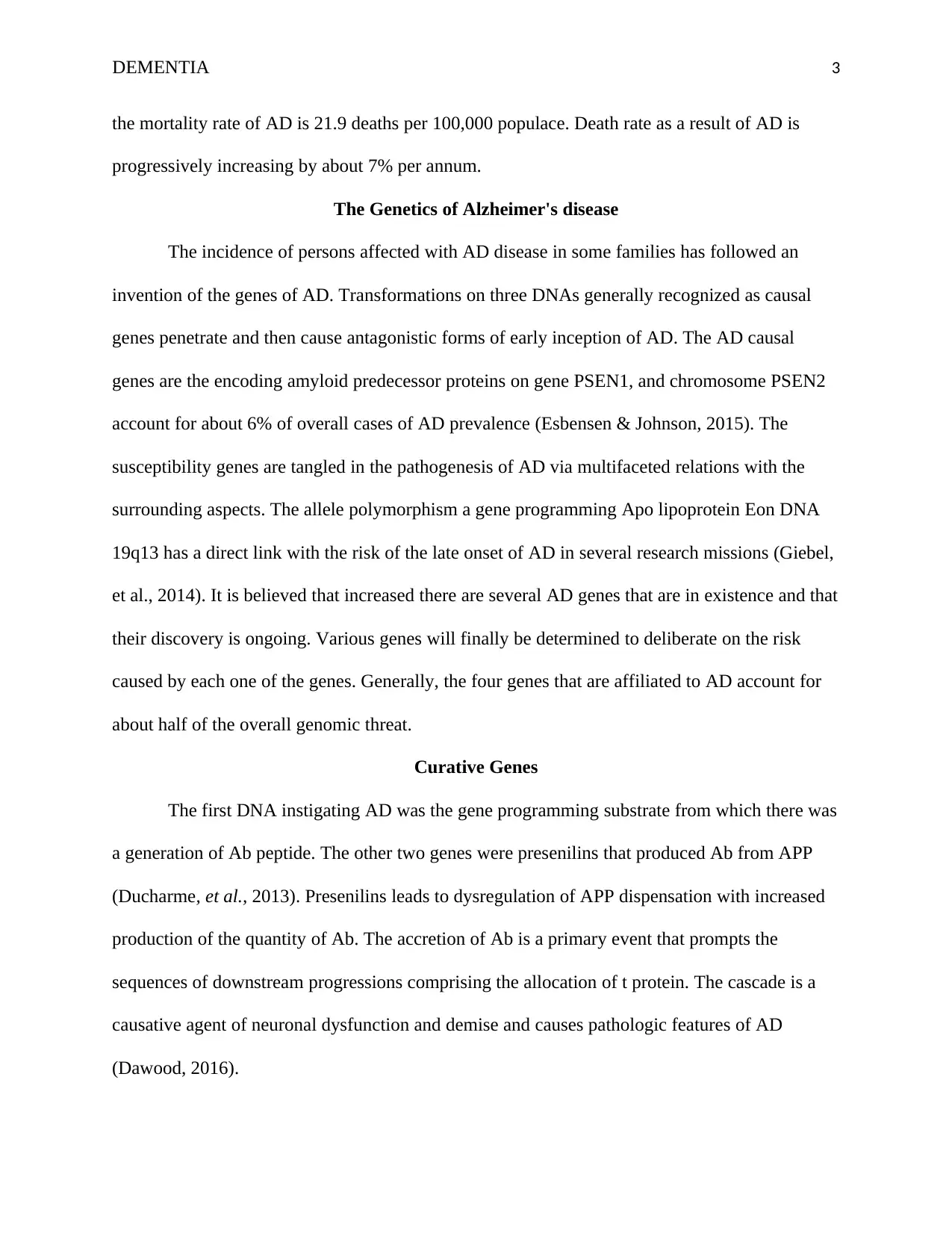
DEMENTIA 3
the mortality rate of AD is 21.9 deaths per 100,000 populace. Death rate as a result of AD is
progressively increasing by about 7% per annum.
The Genetics of Alzheimer's disease
The incidence of persons affected with AD disease in some families has followed an
invention of the genes of AD. Transformations on three DNAs generally recognized as causal
genes penetrate and then cause antagonistic forms of early inception of AD. The AD causal
genes are the encoding amyloid predecessor proteins on gene PSEN1, and chromosome PSEN2
account for about 6% of overall cases of AD prevalence (Esbensen & Johnson, 2015). The
susceptibility genes are tangled in the pathogenesis of AD via multifaceted relations with the
surrounding aspects. The allele polymorphism a gene programming Apo lipoprotein Eon DNA
19q13 has a direct link with the risk of the late onset of AD in several research missions (Giebel,
et al., 2014). It is believed that increased there are several AD genes that are in existence and that
their discovery is ongoing. Various genes will finally be determined to deliberate on the risk
caused by each one of the genes. Generally, the four genes that are affiliated to AD account for
about half of the overall genomic threat.
Curative Genes
The first DNA instigating AD was the gene programming substrate from which there was
a generation of Ab peptide. The other two genes were presenilins that produced Ab from APP
(Ducharme, et al., 2013). Presenilins leads to dysregulation of APP dispensation with increased
production of the quantity of Ab. The accretion of Ab is a primary event that prompts the
sequences of downstream progressions comprising the allocation of t protein. The cascade is a
causative agent of neuronal dysfunction and demise and causes pathologic features of AD
(Dawood, 2016).
the mortality rate of AD is 21.9 deaths per 100,000 populace. Death rate as a result of AD is
progressively increasing by about 7% per annum.
The Genetics of Alzheimer's disease
The incidence of persons affected with AD disease in some families has followed an
invention of the genes of AD. Transformations on three DNAs generally recognized as causal
genes penetrate and then cause antagonistic forms of early inception of AD. The AD causal
genes are the encoding amyloid predecessor proteins on gene PSEN1, and chromosome PSEN2
account for about 6% of overall cases of AD prevalence (Esbensen & Johnson, 2015). The
susceptibility genes are tangled in the pathogenesis of AD via multifaceted relations with the
surrounding aspects. The allele polymorphism a gene programming Apo lipoprotein Eon DNA
19q13 has a direct link with the risk of the late onset of AD in several research missions (Giebel,
et al., 2014). It is believed that increased there are several AD genes that are in existence and that
their discovery is ongoing. Various genes will finally be determined to deliberate on the risk
caused by each one of the genes. Generally, the four genes that are affiliated to AD account for
about half of the overall genomic threat.
Curative Genes
The first DNA instigating AD was the gene programming substrate from which there was
a generation of Ab peptide. The other two genes were presenilins that produced Ab from APP
(Ducharme, et al., 2013). Presenilins leads to dysregulation of APP dispensation with increased
production of the quantity of Ab. The accretion of Ab is a primary event that prompts the
sequences of downstream progressions comprising the allocation of t protein. The cascade is a
causative agent of neuronal dysfunction and demise and causes pathologic features of AD
(Dawood, 2016).
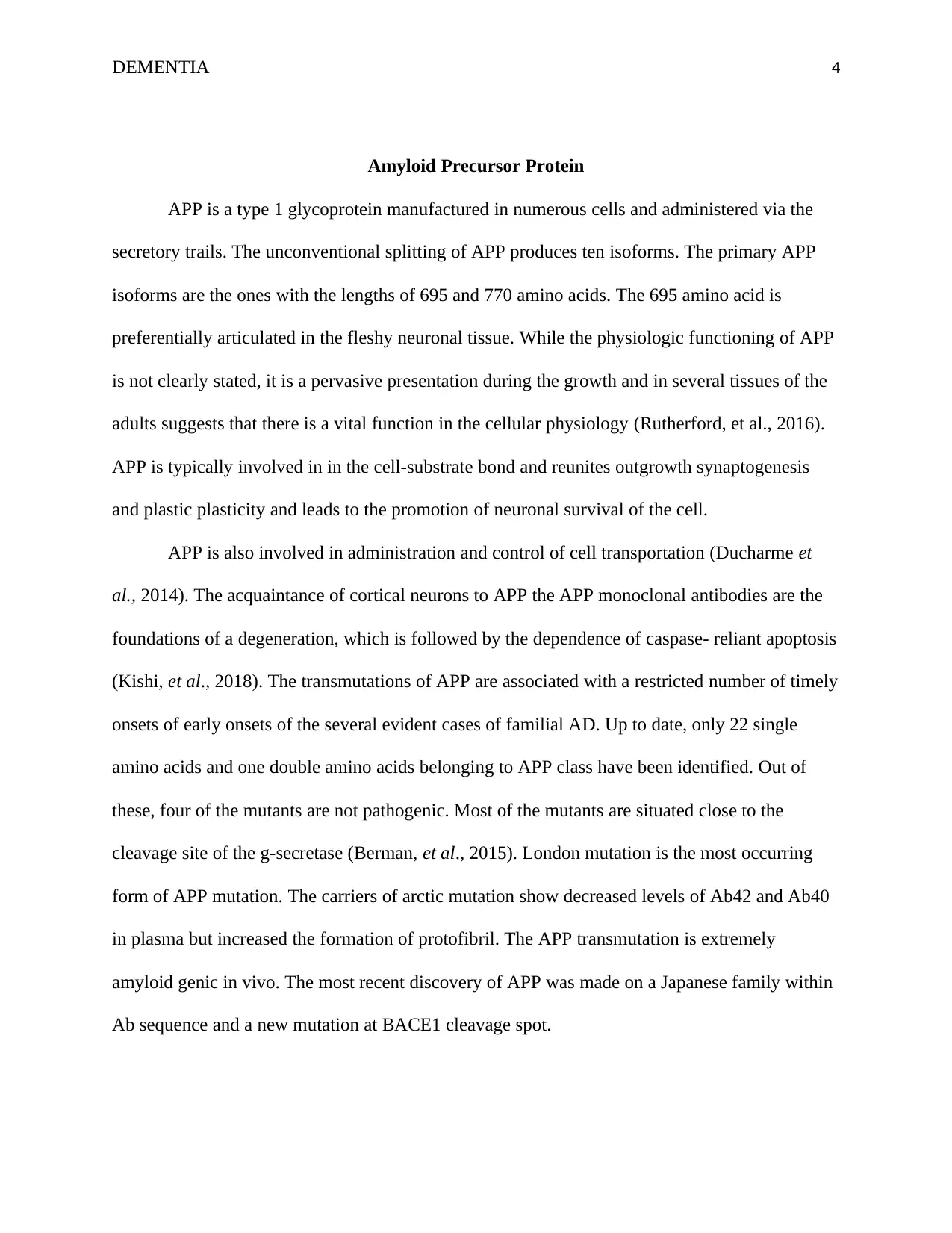
DEMENTIA 4
Amyloid Precursor Protein
APP is a type 1 glycoprotein manufactured in numerous cells and administered via the
secretory trails. The unconventional splitting of APP produces ten isoforms. The primary APP
isoforms are the ones with the lengths of 695 and 770 amino acids. The 695 amino acid is
preferentially articulated in the fleshy neuronal tissue. While the physiologic functioning of APP
is not clearly stated, it is a pervasive presentation during the growth and in several tissues of the
adults suggests that there is a vital function in the cellular physiology (Rutherford, et al., 2016).
APP is typically involved in in the cell-substrate bond and reunites outgrowth synaptogenesis
and plastic plasticity and leads to the promotion of neuronal survival of the cell.
APP is also involved in administration and control of cell transportation (Ducharme et
al., 2014). The acquaintance of cortical neurons to APP the APP monoclonal antibodies are the
foundations of a degeneration, which is followed by the dependence of caspase- reliant apoptosis
(Kishi, et al., 2018). The transmutations of APP are associated with a restricted number of timely
onsets of early onsets of the several evident cases of familial AD. Up to date, only 22 single
amino acids and one double amino acids belonging to APP class have been identified. Out of
these, four of the mutants are not pathogenic. Most of the mutants are situated close to the
cleavage site of the g-secretase (Berman, et al., 2015). London mutation is the most occurring
form of APP mutation. The carriers of arctic mutation show decreased levels of Ab42 and Ab40
in plasma but increased the formation of protofibril. The APP transmutation is extremely
amyloid genic in vivo. The most recent discovery of APP was made on a Japanese family within
Ab sequence and a new mutation at BACE1 cleavage spot.
Amyloid Precursor Protein
APP is a type 1 glycoprotein manufactured in numerous cells and administered via the
secretory trails. The unconventional splitting of APP produces ten isoforms. The primary APP
isoforms are the ones with the lengths of 695 and 770 amino acids. The 695 amino acid is
preferentially articulated in the fleshy neuronal tissue. While the physiologic functioning of APP
is not clearly stated, it is a pervasive presentation during the growth and in several tissues of the
adults suggests that there is a vital function in the cellular physiology (Rutherford, et al., 2016).
APP is typically involved in in the cell-substrate bond and reunites outgrowth synaptogenesis
and plastic plasticity and leads to the promotion of neuronal survival of the cell.
APP is also involved in administration and control of cell transportation (Ducharme et
al., 2014). The acquaintance of cortical neurons to APP the APP monoclonal antibodies are the
foundations of a degeneration, which is followed by the dependence of caspase- reliant apoptosis
(Kishi, et al., 2018). The transmutations of APP are associated with a restricted number of timely
onsets of early onsets of the several evident cases of familial AD. Up to date, only 22 single
amino acids and one double amino acids belonging to APP class have been identified. Out of
these, four of the mutants are not pathogenic. Most of the mutants are situated close to the
cleavage site of the g-secretase (Berman, et al., 2015). London mutation is the most occurring
form of APP mutation. The carriers of arctic mutation show decreased levels of Ab42 and Ab40
in plasma but increased the formation of protofibril. The APP transmutation is extremely
amyloid genic in vivo. The most recent discovery of APP was made on a Japanese family within
Ab sequence and a new mutation at BACE1 cleavage spot.
Secure Best Marks with AI Grader
Need help grading? Try our AI Grader for instant feedback on your assignments.
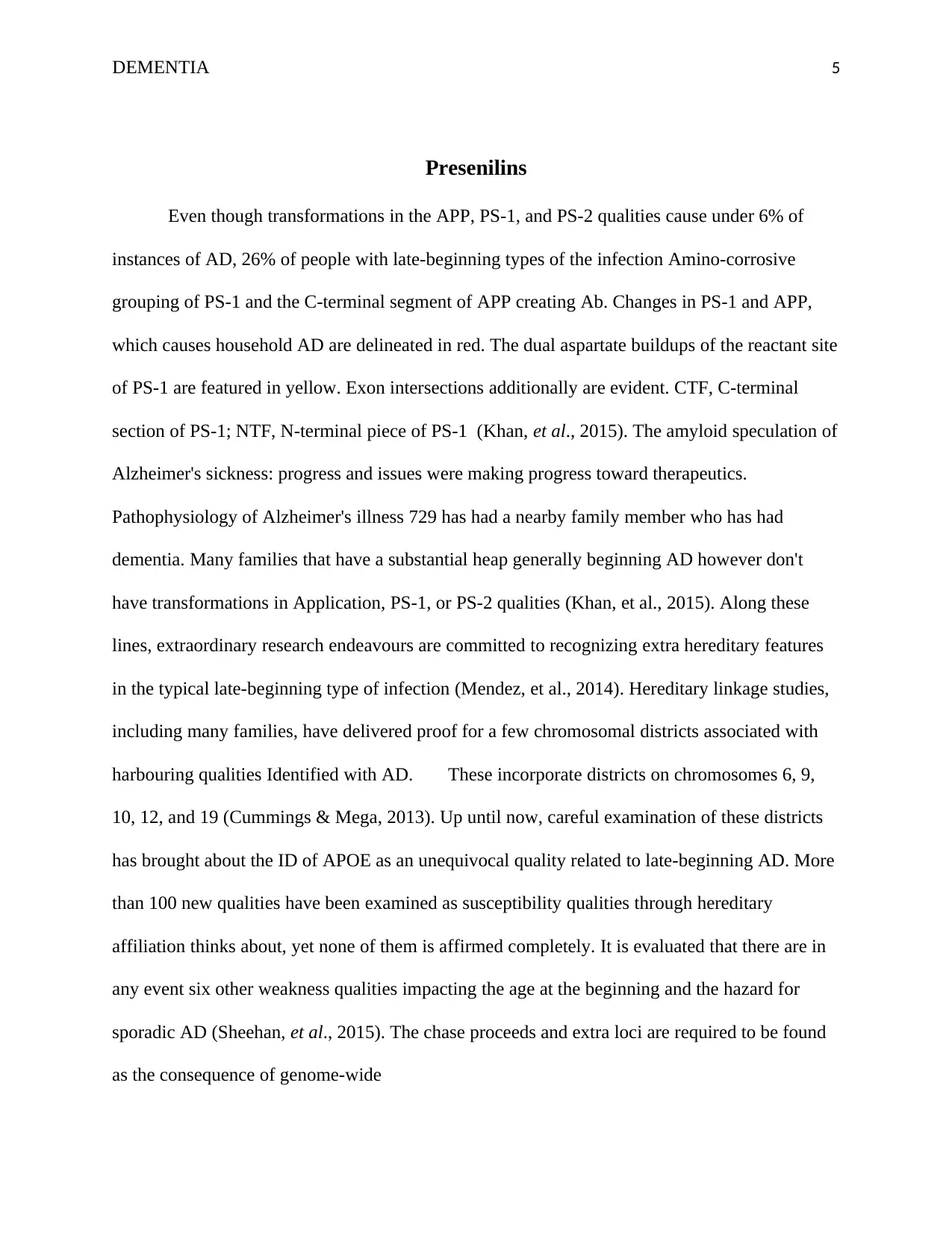
DEMENTIA 5
Presenilins
Even though transformations in the APP, PS-1, and PS-2 qualities cause under 6% of
instances of AD, 26% of people with late-beginning types of the infection Amino-corrosive
grouping of PS-1 and the C-terminal segment of APP creating Ab. Changes in PS-1 and APP,
which causes household AD are delineated in red. The dual aspartate buildups of the reactant site
of PS-1 are featured in yellow. Exon intersections additionally are evident. CTF, C-terminal
section of PS-1; NTF, N-terminal piece of PS-1 (Khan, et al., 2015). The amyloid speculation of
Alzheimer's sickness: progress and issues were making progress toward therapeutics.
Pathophysiology of Alzheimer's illness 729 has had a nearby family member who has had
dementia. Many families that have a substantial heap generally beginning AD however don't
have transformations in Application, PS-1, or PS-2 qualities (Khan, et al., 2015). Along these
lines, extraordinary research endeavours are committed to recognizing extra hereditary features
in the typical late-beginning type of infection (Mendez, et al., 2014). Hereditary linkage studies,
including many families, have delivered proof for a few chromosomal districts associated with
harbouring qualities Identified with AD. These incorporate districts on chromosomes 6, 9,
10, 12, and 19 (Cummings & Mega, 2013). Up until now, careful examination of these districts
has brought about the ID of APOE as an unequivocal quality related to late-beginning AD. More
than 100 new qualities have been examined as susceptibility qualities through hereditary
affiliation thinks about, yet none of them is affirmed completely. It is evaluated that there are in
any event six other weakness qualities impacting the age at the beginning and the hazard for
sporadic AD (Sheehan, et al., 2015). The chase proceeds and extra loci are required to be found
as the consequence of genome-wide
Presenilins
Even though transformations in the APP, PS-1, and PS-2 qualities cause under 6% of
instances of AD, 26% of people with late-beginning types of the infection Amino-corrosive
grouping of PS-1 and the C-terminal segment of APP creating Ab. Changes in PS-1 and APP,
which causes household AD are delineated in red. The dual aspartate buildups of the reactant site
of PS-1 are featured in yellow. Exon intersections additionally are evident. CTF, C-terminal
section of PS-1; NTF, N-terminal piece of PS-1 (Khan, et al., 2015). The amyloid speculation of
Alzheimer's sickness: progress and issues were making progress toward therapeutics.
Pathophysiology of Alzheimer's illness 729 has had a nearby family member who has had
dementia. Many families that have a substantial heap generally beginning AD however don't
have transformations in Application, PS-1, or PS-2 qualities (Khan, et al., 2015). Along these
lines, extraordinary research endeavours are committed to recognizing extra hereditary features
in the typical late-beginning type of infection (Mendez, et al., 2014). Hereditary linkage studies,
including many families, have delivered proof for a few chromosomal districts associated with
harbouring qualities Identified with AD. These incorporate districts on chromosomes 6, 9,
10, 12, and 19 (Cummings & Mega, 2013). Up until now, careful examination of these districts
has brought about the ID of APOE as an unequivocal quality related to late-beginning AD. More
than 100 new qualities have been examined as susceptibility qualities through hereditary
affiliation thinks about, yet none of them is affirmed completely. It is evaluated that there are in
any event six other weakness qualities impacting the age at the beginning and the hazard for
sporadic AD (Sheehan, et al., 2015). The chase proceeds and extra loci are required to be found
as the consequence of genome-wide
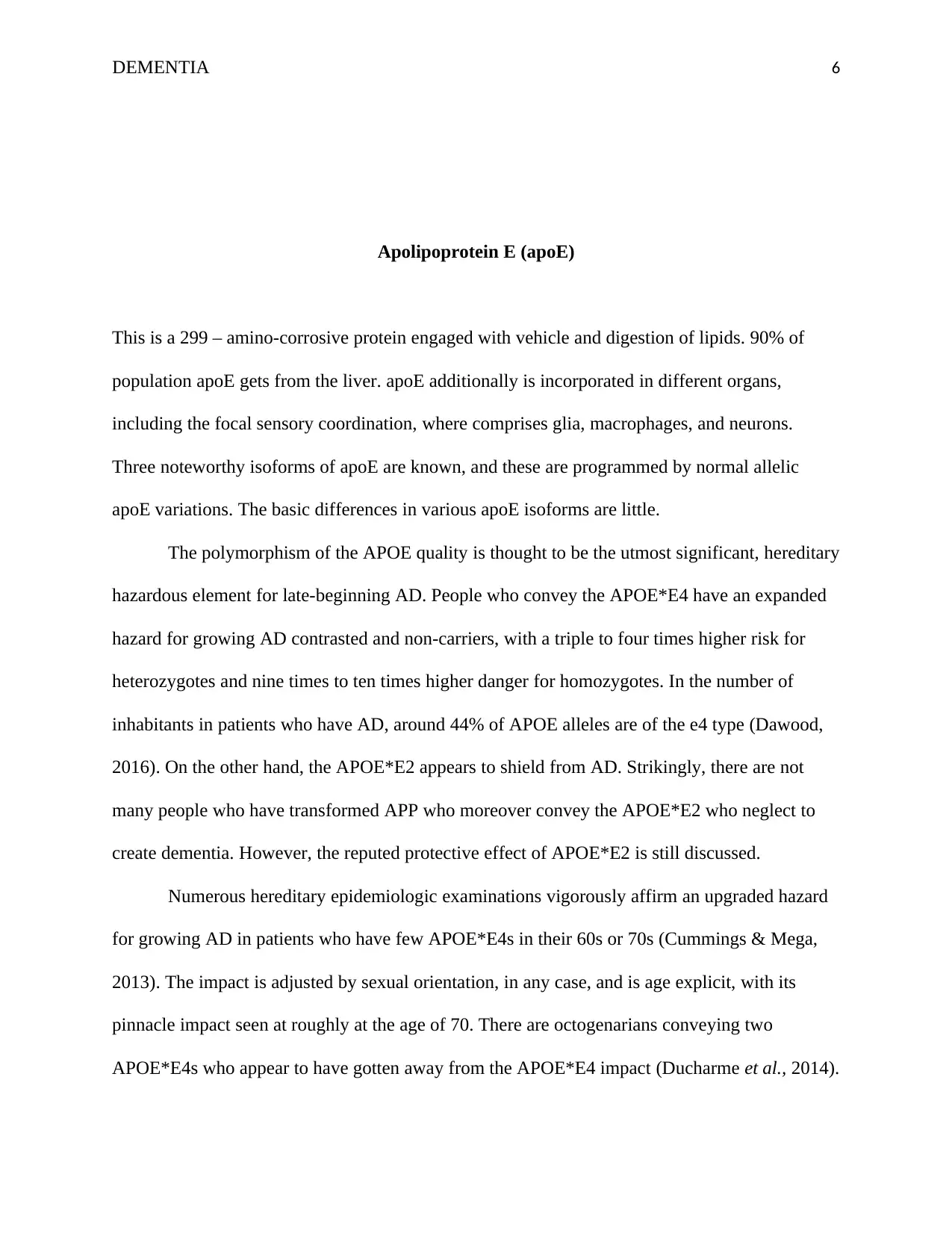
DEMENTIA 6
Apolipoprotein E (apoE)
This is a 299 – amino-corrosive protein engaged with vehicle and digestion of lipids. 90% of
population apoE gets from the liver. apoE additionally is incorporated in different organs,
including the focal sensory coordination, where comprises glia, macrophages, and neurons.
Three noteworthy isoforms of apoE are known, and these are programmed by normal allelic
apoE variations. The basic differences in various apoE isoforms are little.
The polymorphism of the APOE quality is thought to be the utmost significant, hereditary
hazardous element for late-beginning AD. People who convey the APOE*E4 have an expanded
hazard for growing AD contrasted and non-carriers, with a triple to four times higher risk for
heterozygotes and nine times to ten times higher danger for homozygotes. In the number of
inhabitants in patients who have AD, around 44% of APOE alleles are of the e4 type (Dawood,
2016). On the other hand, the APOE*E2 appears to shield from AD. Strikingly, there are not
many people who have transformed APP who moreover convey the APOE*E2 who neglect to
create dementia. However, the reputed protective effect of APOE*E2 is still discussed.
Numerous hereditary epidemiologic examinations vigorously affirm an upgraded hazard
for growing AD in patients who have few APOE*E4s in their 60s or 70s (Cummings & Mega,
2013). The impact is adjusted by sexual orientation, in any case, and is age explicit, with its
pinnacle impact seen at roughly at the age of 70. There are octogenarians conveying two
APOE*E4s who appear to have gotten away from the APOE*E4 impact (Ducharme et al., 2014).
Apolipoprotein E (apoE)
This is a 299 – amino-corrosive protein engaged with vehicle and digestion of lipids. 90% of
population apoE gets from the liver. apoE additionally is incorporated in different organs,
including the focal sensory coordination, where comprises glia, macrophages, and neurons.
Three noteworthy isoforms of apoE are known, and these are programmed by normal allelic
apoE variations. The basic differences in various apoE isoforms are little.
The polymorphism of the APOE quality is thought to be the utmost significant, hereditary
hazardous element for late-beginning AD. People who convey the APOE*E4 have an expanded
hazard for growing AD contrasted and non-carriers, with a triple to four times higher risk for
heterozygotes and nine times to ten times higher danger for homozygotes. In the number of
inhabitants in patients who have AD, around 44% of APOE alleles are of the e4 type (Dawood,
2016). On the other hand, the APOE*E2 appears to shield from AD. Strikingly, there are not
many people who have transformed APP who moreover convey the APOE*E2 who neglect to
create dementia. However, the reputed protective effect of APOE*E2 is still discussed.
Numerous hereditary epidemiologic examinations vigorously affirm an upgraded hazard
for growing AD in patients who have few APOE*E4s in their 60s or 70s (Cummings & Mega,
2013). The impact is adjusted by sexual orientation, in any case, and is age explicit, with its
pinnacle impact seen at roughly at the age of 70. There are octogenarians conveying two
APOE*E4s who appear to have gotten away from the APOE*E4 impact (Ducharme et al., 2014).
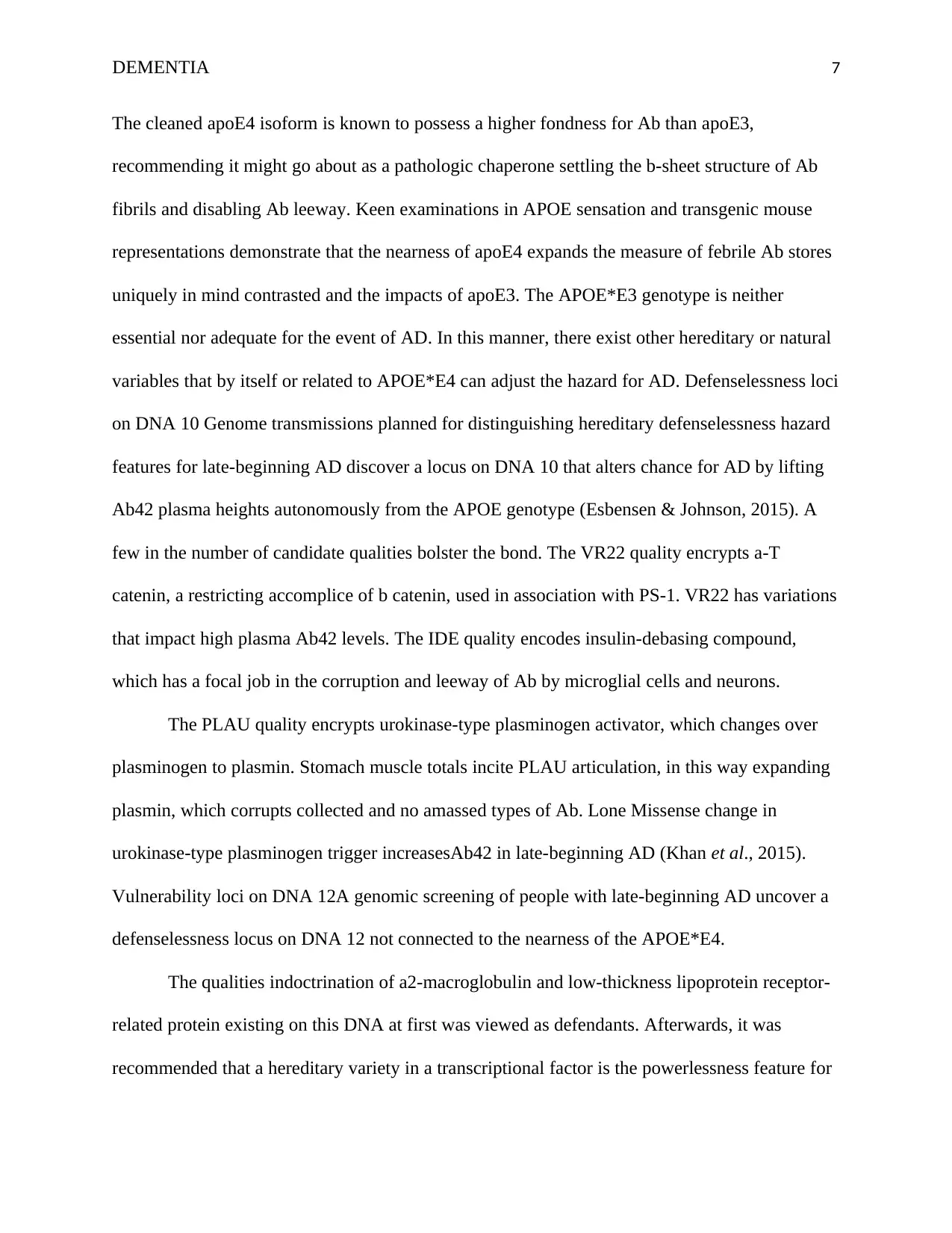
DEMENTIA 7
The cleaned apoE4 isoform is known to possess a higher fondness for Ab than apoE3,
recommending it might go about as a pathologic chaperone settling the b-sheet structure of Ab
fibrils and disabling Ab leeway. Keen examinations in APOE sensation and transgenic mouse
representations demonstrate that the nearness of apoE4 expands the measure of febrile Ab stores
uniquely in mind contrasted and the impacts of apoE3. The APOE*E3 genotype is neither
essential nor adequate for the event of AD. In this manner, there exist other hereditary or natural
variables that by itself or related to APOE*E4 can adjust the hazard for AD. Defenselessness loci
on DNA 10 Genome transmissions planned for distinguishing hereditary defenselessness hazard
features for late-beginning AD discover a locus on DNA 10 that alters chance for AD by lifting
Ab42 plasma heights autonomously from the APOE genotype (Esbensen & Johnson, 2015). A
few in the number of candidate qualities bolster the bond. The VR22 quality encrypts a-T
catenin, a restricting accomplice of b catenin, used in association with PS-1. VR22 has variations
that impact high plasma Ab42 levels. The IDE quality encodes insulin-debasing compound,
which has a focal job in the corruption and leeway of Ab by microglial cells and neurons.
The PLAU quality encrypts urokinase-type plasminogen activator, which changes over
plasminogen to plasmin. Stomach muscle totals incite PLAU articulation, in this way expanding
plasmin, which corrupts collected and no amassed types of Ab. Lone Missense change in
urokinase-type plasminogen trigger increasesAb42 in late-beginning AD (Khan et al., 2015).
Vulnerability loci on DNA 12A genomic screening of people with late-beginning AD uncover a
defenselessness locus on DNA 12 not connected to the nearness of the APOE*E4.
The qualities indoctrination of a2-macroglobulin and low-thickness lipoprotein receptor-
related protein existing on this DNA at first was viewed as defendants. Afterwards, it was
recommended that a hereditary variety in a transcriptional factor is the powerlessness feature for
The cleaned apoE4 isoform is known to possess a higher fondness for Ab than apoE3,
recommending it might go about as a pathologic chaperone settling the b-sheet structure of Ab
fibrils and disabling Ab leeway. Keen examinations in APOE sensation and transgenic mouse
representations demonstrate that the nearness of apoE4 expands the measure of febrile Ab stores
uniquely in mind contrasted and the impacts of apoE3. The APOE*E3 genotype is neither
essential nor adequate for the event of AD. In this manner, there exist other hereditary or natural
variables that by itself or related to APOE*E4 can adjust the hazard for AD. Defenselessness loci
on DNA 10 Genome transmissions planned for distinguishing hereditary defenselessness hazard
features for late-beginning AD discover a locus on DNA 10 that alters chance for AD by lifting
Ab42 plasma heights autonomously from the APOE genotype (Esbensen & Johnson, 2015). A
few in the number of candidate qualities bolster the bond. The VR22 quality encrypts a-T
catenin, a restricting accomplice of b catenin, used in association with PS-1. VR22 has variations
that impact high plasma Ab42 levels. The IDE quality encodes insulin-debasing compound,
which has a focal job in the corruption and leeway of Ab by microglial cells and neurons.
The PLAU quality encrypts urokinase-type plasminogen activator, which changes over
plasminogen to plasmin. Stomach muscle totals incite PLAU articulation, in this way expanding
plasmin, which corrupts collected and no amassed types of Ab. Lone Missense change in
urokinase-type plasminogen trigger increasesAb42 in late-beginning AD (Khan et al., 2015).
Vulnerability loci on DNA 12A genomic screening of people with late-beginning AD uncover a
defenselessness locus on DNA 12 not connected to the nearness of the APOE*E4.
The qualities indoctrination of a2-macroglobulin and low-thickness lipoprotein receptor-
related protein existing on this DNA at first was viewed as defendants. Afterwards, it was
recommended that a hereditary variety in a transcriptional factor is the powerlessness feature for
Paraphrase This Document
Need a fresh take? Get an instant paraphrase of this document with our AI Paraphraser
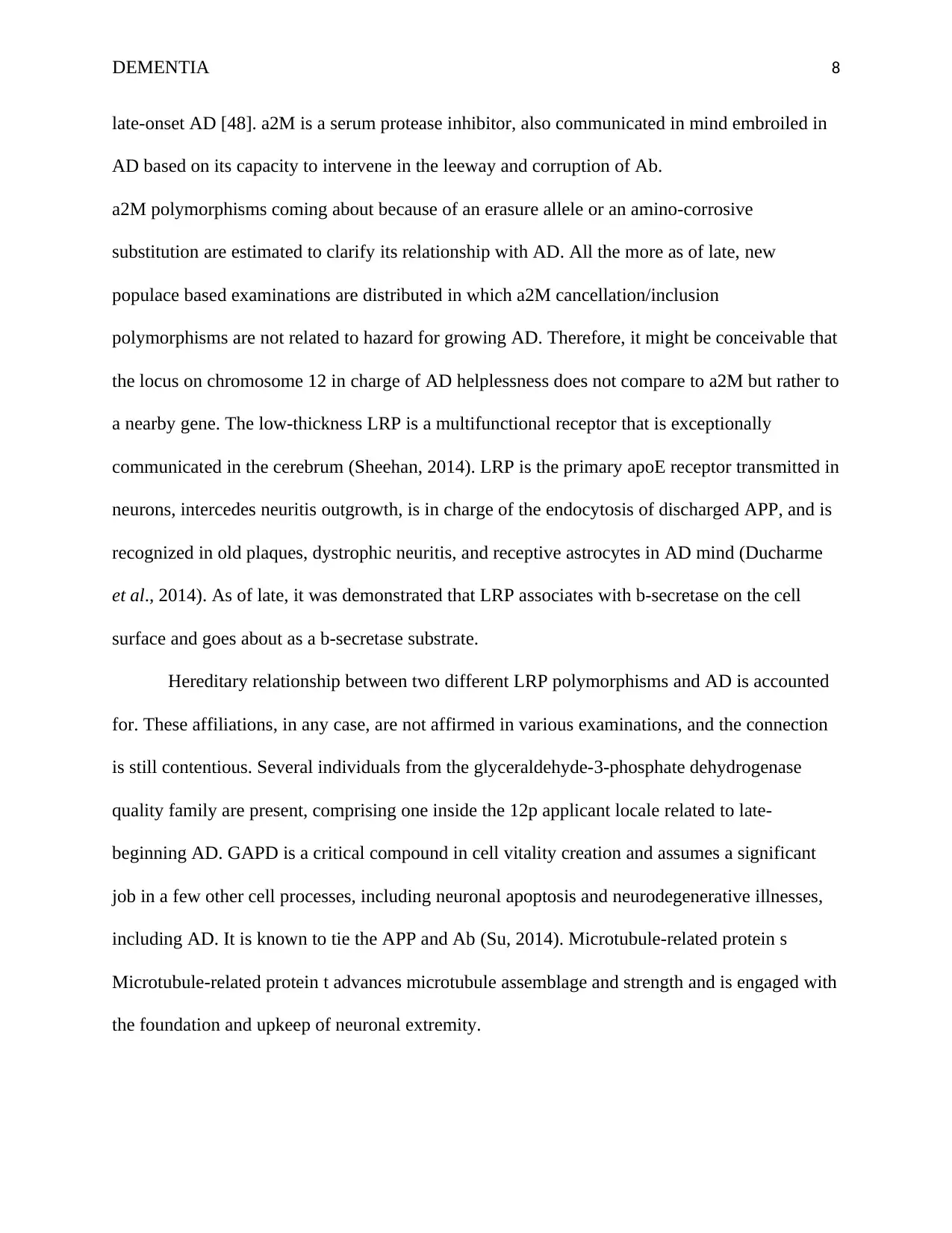
DEMENTIA 8
late-onset AD [48]. a2M is a serum protease inhibitor, also communicated in mind embroiled in
AD based on its capacity to intervene in the leeway and corruption of Ab.
a2M polymorphisms coming about because of an erasure allele or an amino-corrosive
substitution are estimated to clarify its relationship with AD. All the more as of late, new
populace based examinations are distributed in which a2M cancellation/inclusion
polymorphisms are not related to hazard for growing AD. Therefore, it might be conceivable that
the locus on chromosome 12 in charge of AD helplessness does not compare to a2M but rather to
a nearby gene. The low-thickness LRP is a multifunctional receptor that is exceptionally
communicated in the cerebrum (Sheehan, 2014). LRP is the primary apoE receptor transmitted in
neurons, intercedes neuritis outgrowth, is in charge of the endocytosis of discharged APP, and is
recognized in old plaques, dystrophic neuritis, and receptive astrocytes in AD mind (Ducharme
et al., 2014). As of late, it was demonstrated that LRP associates with b-secretase on the cell
surface and goes about as a b-secretase substrate.
Hereditary relationship between two different LRP polymorphisms and AD is accounted
for. These affiliations, in any case, are not affirmed in various examinations, and the connection
is still contentious. Several individuals from the glyceraldehyde-3-phosphate dehydrogenase
quality family are present, comprising one inside the 12p applicant locale related to late-
beginning AD. GAPD is a critical compound in cell vitality creation and assumes a significant
job in a few other cell processes, including neuronal apoptosis and neurodegenerative illnesses,
including AD. It is known to tie the APP and Ab (Su, 2014). Microtubule-related protein s
Microtubule-related protein t advances microtubule assemblage and strength and is engaged with
the foundation and upkeep of neuronal extremity.
late-onset AD [48]. a2M is a serum protease inhibitor, also communicated in mind embroiled in
AD based on its capacity to intervene in the leeway and corruption of Ab.
a2M polymorphisms coming about because of an erasure allele or an amino-corrosive
substitution are estimated to clarify its relationship with AD. All the more as of late, new
populace based examinations are distributed in which a2M cancellation/inclusion
polymorphisms are not related to hazard for growing AD. Therefore, it might be conceivable that
the locus on chromosome 12 in charge of AD helplessness does not compare to a2M but rather to
a nearby gene. The low-thickness LRP is a multifunctional receptor that is exceptionally
communicated in the cerebrum (Sheehan, 2014). LRP is the primary apoE receptor transmitted in
neurons, intercedes neuritis outgrowth, is in charge of the endocytosis of discharged APP, and is
recognized in old plaques, dystrophic neuritis, and receptive astrocytes in AD mind (Ducharme
et al., 2014). As of late, it was demonstrated that LRP associates with b-secretase on the cell
surface and goes about as a b-secretase substrate.
Hereditary relationship between two different LRP polymorphisms and AD is accounted
for. These affiliations, in any case, are not affirmed in various examinations, and the connection
is still contentious. Several individuals from the glyceraldehyde-3-phosphate dehydrogenase
quality family are present, comprising one inside the 12p applicant locale related to late-
beginning AD. GAPD is a critical compound in cell vitality creation and assumes a significant
job in a few other cell processes, including neuronal apoptosis and neurodegenerative illnesses,
including AD. It is known to tie the APP and Ab (Su, 2014). Microtubule-related protein s
Microtubule-related protein t advances microtubule assemblage and strength and is engaged with
the foundation and upkeep of neuronal extremity.
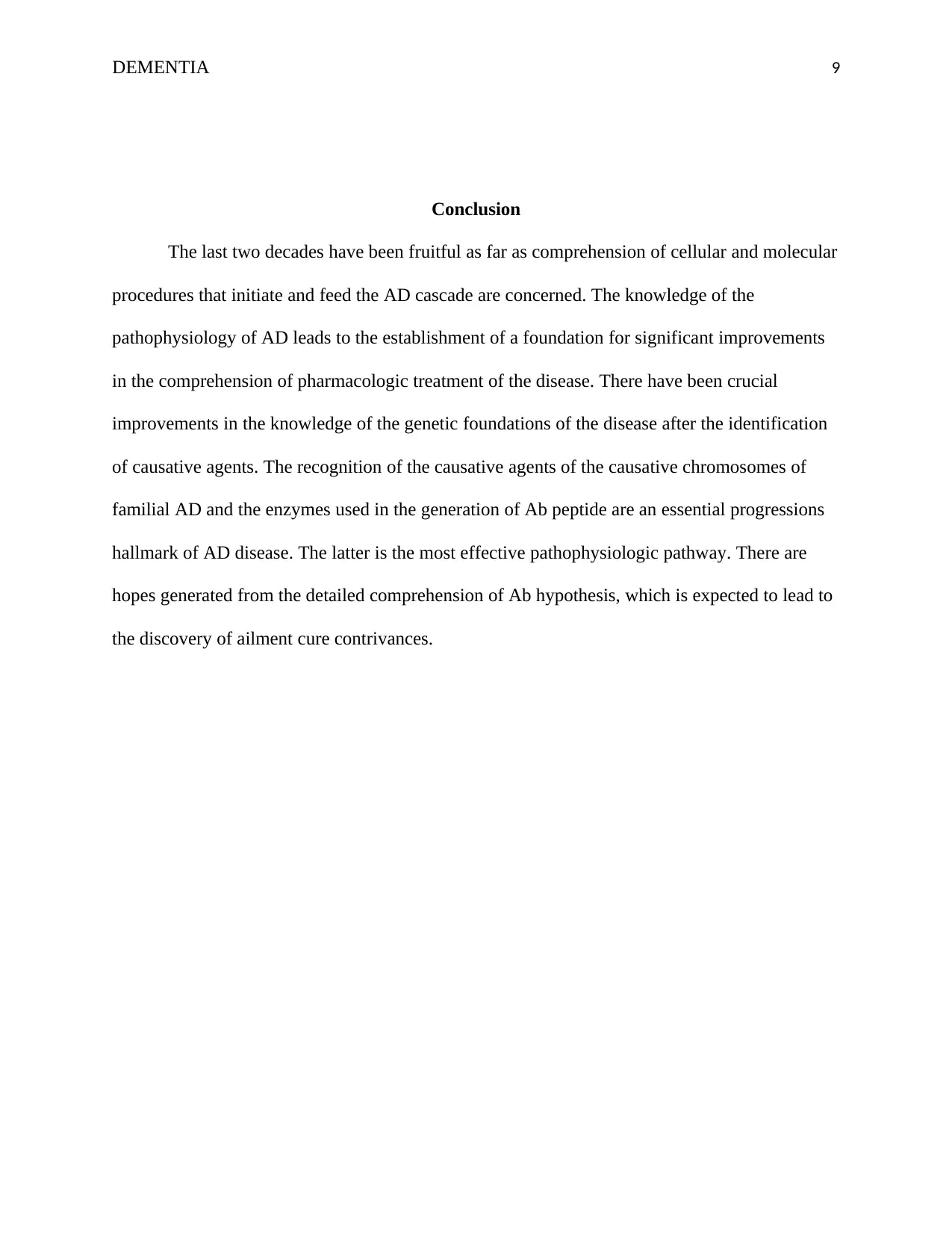
DEMENTIA 9
Conclusion
The last two decades have been fruitful as far as comprehension of cellular and molecular
procedures that initiate and feed the AD cascade are concerned. The knowledge of the
pathophysiology of AD leads to the establishment of a foundation for significant improvements
in the comprehension of pharmacologic treatment of the disease. There have been crucial
improvements in the knowledge of the genetic foundations of the disease after the identification
of causative agents. The recognition of the causative agents of the causative chromosomes of
familial AD and the enzymes used in the generation of Ab peptide are an essential progressions
hallmark of AD disease. The latter is the most effective pathophysiologic pathway. There are
hopes generated from the detailed comprehension of Ab hypothesis, which is expected to lead to
the discovery of ailment cure contrivances.
Conclusion
The last two decades have been fruitful as far as comprehension of cellular and molecular
procedures that initiate and feed the AD cascade are concerned. The knowledge of the
pathophysiology of AD leads to the establishment of a foundation for significant improvements
in the comprehension of pharmacologic treatment of the disease. There have been crucial
improvements in the knowledge of the genetic foundations of the disease after the identification
of causative agents. The recognition of the causative agents of the causative chromosomes of
familial AD and the enzymes used in the generation of Ab peptide are an essential progressions
hallmark of AD disease. The latter is the most effective pathophysiologic pathway. There are
hopes generated from the detailed comprehension of Ab hypothesis, which is expected to lead to
the discovery of ailment cure contrivances.
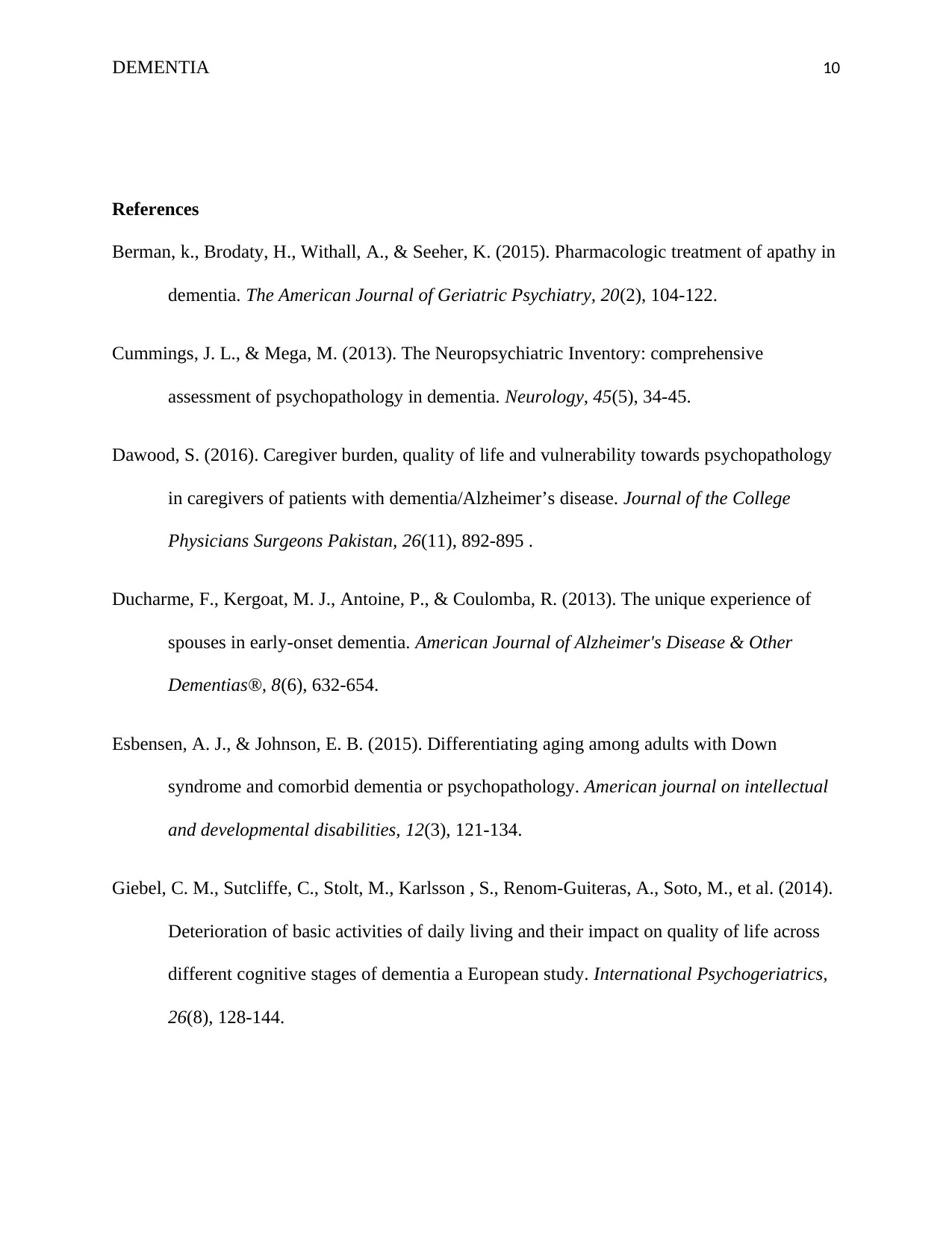
DEMENTIA 10
References
Berman, k., Brodaty, H., Withall, A., & Seeher, K. (2015). Pharmacologic treatment of apathy in
dementia. The American Journal of Geriatric Psychiatry, 20(2), 104-122.
Cummings, J. L., & Mega, M. (2013). The Neuropsychiatric Inventory: comprehensive
assessment of psychopathology in dementia. Neurology, 45(5), 34-45.
Dawood, S. (2016). Caregiver burden, quality of life and vulnerability towards psychopathology
in caregivers of patients with dementia/Alzheimer’s disease. Journal of the College
Physicians Surgeons Pakistan, 26(11), 892-895 .
Ducharme, F., Kergoat, M. J., Antoine, P., & Coulomba, R. (2013). The unique experience of
spouses in early-onset dementia. American Journal of Alzheimer's Disease & Other
Dementias®, 8(6), 632-654.
Esbensen, A. J., & Johnson, E. B. (2015). Differentiating aging among adults with Down
syndrome and comorbid dementia or psychopathology. American journal on intellectual
and developmental disabilities, 12(3), 121-134.
Giebel, C. M., Sutcliffe, C., Stolt, M., Karlsson , S., Renom-Guiteras, A., Soto, M., et al. (2014).
Deterioration of basic activities of daily living and their impact on quality of life across
different cognitive stages of dementia a European study. International Psychogeriatrics,
26(8), 128-144.
References
Berman, k., Brodaty, H., Withall, A., & Seeher, K. (2015). Pharmacologic treatment of apathy in
dementia. The American Journal of Geriatric Psychiatry, 20(2), 104-122.
Cummings, J. L., & Mega, M. (2013). The Neuropsychiatric Inventory: comprehensive
assessment of psychopathology in dementia. Neurology, 45(5), 34-45.
Dawood, S. (2016). Caregiver burden, quality of life and vulnerability towards psychopathology
in caregivers of patients with dementia/Alzheimer’s disease. Journal of the College
Physicians Surgeons Pakistan, 26(11), 892-895 .
Ducharme, F., Kergoat, M. J., Antoine, P., & Coulomba, R. (2013). The unique experience of
spouses in early-onset dementia. American Journal of Alzheimer's Disease & Other
Dementias®, 8(6), 632-654.
Esbensen, A. J., & Johnson, E. B. (2015). Differentiating aging among adults with Down
syndrome and comorbid dementia or psychopathology. American journal on intellectual
and developmental disabilities, 12(3), 121-134.
Giebel, C. M., Sutcliffe, C., Stolt, M., Karlsson , S., Renom-Guiteras, A., Soto, M., et al. (2014).
Deterioration of basic activities of daily living and their impact on quality of life across
different cognitive stages of dementia a European study. International Psychogeriatrics,
26(8), 128-144.
Secure Best Marks with AI Grader
Need help grading? Try our AI Grader for instant feedback on your assignments.
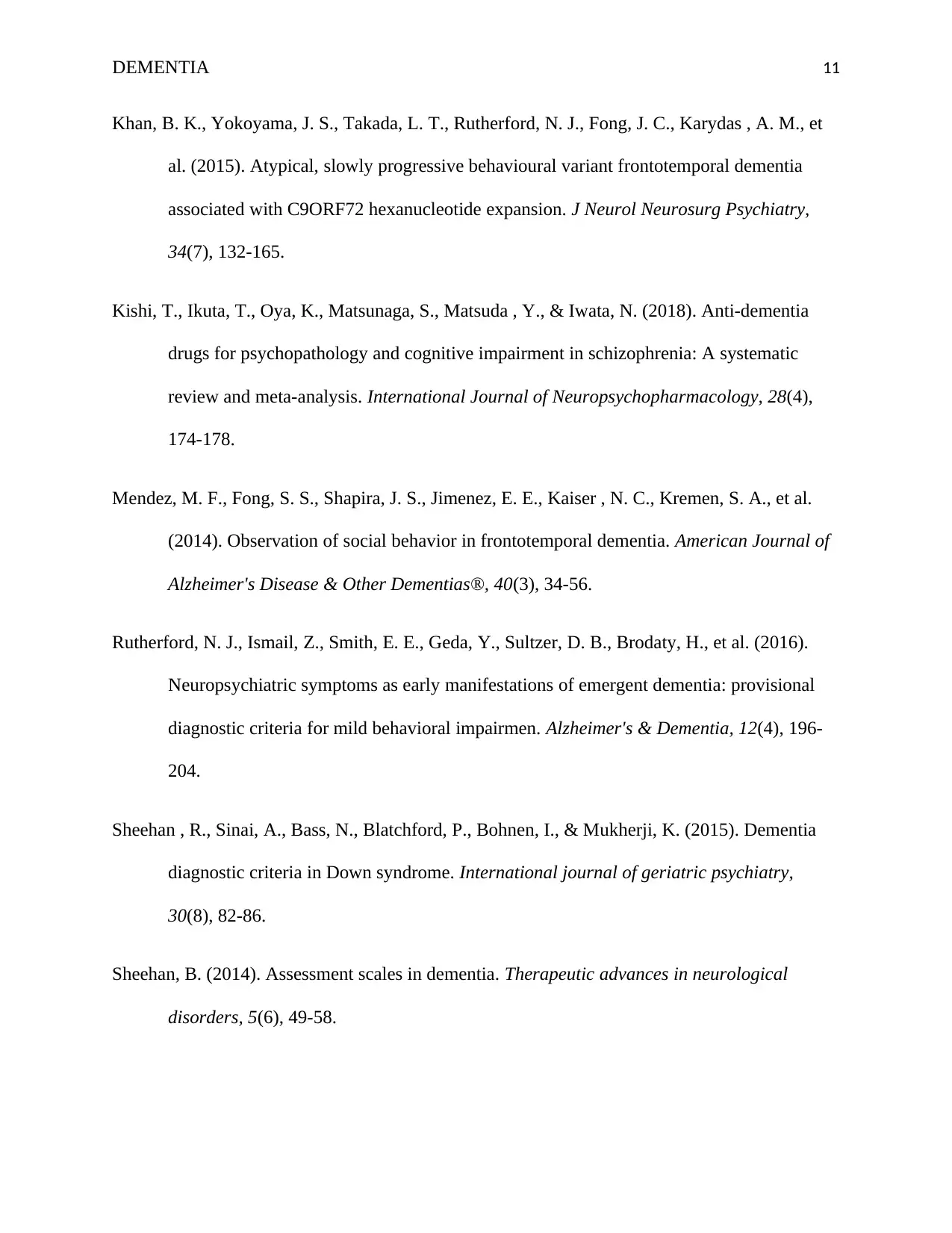
DEMENTIA 11
Khan, B. K., Yokoyama, J. S., Takada, L. T., Rutherford, N. J., Fong, J. C., Karydas , A. M., et
al. (2015). Atypical, slowly progressive behavioural variant frontotemporal dementia
associated with C9ORF72 hexanucleotide expansion. J Neurol Neurosurg Psychiatry,
34(7), 132-165.
Kishi, T., Ikuta, T., Oya, K., Matsunaga, S., Matsuda , Y., & Iwata, N. (2018). Anti-dementia
drugs for psychopathology and cognitive impairment in schizophrenia: A systematic
review and meta-analysis. International Journal of Neuropsychopharmacology, 28(4),
174-178.
Mendez, M. F., Fong, S. S., Shapira, J. S., Jimenez, E. E., Kaiser , N. C., Kremen, S. A., et al.
(2014). Observation of social behavior in frontotemporal dementia. American Journal of
Alzheimer's Disease & Other Dementias®, 40(3), 34-56.
Rutherford, N. J., Ismail, Z., Smith, E. E., Geda, Y., Sultzer, D. B., Brodaty, H., et al. (2016).
Neuropsychiatric symptoms as early manifestations of emergent dementia: provisional
diagnostic criteria for mild behavioral impairmen. Alzheimer's & Dementia, 12(4), 196-
204.
Sheehan , R., Sinai, A., Bass, N., Blatchford, P., Bohnen, I., & Mukherji, K. (2015). Dementia
diagnostic criteria in Down syndrome. International journal of geriatric psychiatry,
30(8), 82-86.
Sheehan, B. (2014). Assessment scales in dementia. Therapeutic advances in neurological
disorders, 5(6), 49-58.
Khan, B. K., Yokoyama, J. S., Takada, L. T., Rutherford, N. J., Fong, J. C., Karydas , A. M., et
al. (2015). Atypical, slowly progressive behavioural variant frontotemporal dementia
associated with C9ORF72 hexanucleotide expansion. J Neurol Neurosurg Psychiatry,
34(7), 132-165.
Kishi, T., Ikuta, T., Oya, K., Matsunaga, S., Matsuda , Y., & Iwata, N. (2018). Anti-dementia
drugs for psychopathology and cognitive impairment in schizophrenia: A systematic
review and meta-analysis. International Journal of Neuropsychopharmacology, 28(4),
174-178.
Mendez, M. F., Fong, S. S., Shapira, J. S., Jimenez, E. E., Kaiser , N. C., Kremen, S. A., et al.
(2014). Observation of social behavior in frontotemporal dementia. American Journal of
Alzheimer's Disease & Other Dementias®, 40(3), 34-56.
Rutherford, N. J., Ismail, Z., Smith, E. E., Geda, Y., Sultzer, D. B., Brodaty, H., et al. (2016).
Neuropsychiatric symptoms as early manifestations of emergent dementia: provisional
diagnostic criteria for mild behavioral impairmen. Alzheimer's & Dementia, 12(4), 196-
204.
Sheehan , R., Sinai, A., Bass, N., Blatchford, P., Bohnen, I., & Mukherji, K. (2015). Dementia
diagnostic criteria in Down syndrome. International journal of geriatric psychiatry,
30(8), 82-86.
Sheehan, B. (2014). Assessment scales in dementia. Therapeutic advances in neurological
disorders, 5(6), 49-58.

DEMENTIA 12
Su, K. P. (2014). nflammation in psychopathology of depression: clinical, biological, and
therapeutic implications. BioMedicine, 2(2), 68-74.
Su, K. P. (2014). nflammation in psychopathology of depression: clinical, biological, and
therapeutic implications. BioMedicine, 2(2), 68-74.
1 out of 12
Related Documents
Your All-in-One AI-Powered Toolkit for Academic Success.
+13062052269
info@desklib.com
Available 24*7 on WhatsApp / Email
![[object Object]](/_next/static/media/star-bottom.7253800d.svg)
Unlock your academic potential
© 2024 | Zucol Services PVT LTD | All rights reserved.





